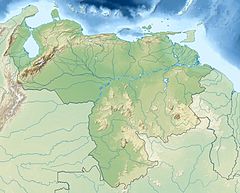Stefania riae
| Stefania riae | |
|---|---|
| Scientific classification | |
| Domain: | Eukaryota |
| Kingdom: | Animalia |
| Phylum: | Chordata |
| Class: | Amphibia |
| Order: | Anura |
| Family: | Hemiphractidae |
| Genus: | Stefania |
| Species: | S. riae
|
| Binomial name | |
| Stefania riae | |
Stefania riae (common name: Sarisarinama carrying frog,[3] Template:Lang-es[1]) is a species of frog in the family Hemiphractidae. This species is only known from Cerro Sarisariñama, a tepui in the Bolívar State, Venezuela.[4][3]
Etymology
The specific name riae honors Ria Hoogmoed-Verschoor, spouse of the second author.[2]
Description
Adult males measure 40–58 mm (1.6–2.3 in) and females 52–60 mm (2.0–2.4 in) in snout–vent length.[3] The tympanum is visible and relatively large. The canthus rostralis is distinct. All fingers and toes have well-developed discs. The toes have basal webbing.[2] There are four color forms without consistent relationship with a specimen's sex. Possible patterns are 1) mostly pale brown, possibly with a few indistinct darker spots, 2) pattern that is other wise variable but always with paler dorsal background than dorsolateral stripes, 3) chevrons or spots on the dorsum, and 4) brown dorsum without dorsolateral stripes and chevrons, but with several dark brown spots and golden spots scattered around the head, body, and limbs. The two first forms are the most common ones.[3]
Habitat and conservation
The type series was collected from the plateau on top of Cerro Sarisarifiama at an elevation of 1,400 m (4,600 ft) above sea level.[2] In 2002, Stefania riae was abundant in humid environments inside the Sima Humboldt (=Sima Mayor) sinkhole (but none were found from near its edge); many specimens were found on mossy walls soaked by water, bushes and plants, and on sandstone walls. None was found One specimen was found on a mossy wall near a small, slow creek on the southern slope of Sarisariñama at 1,328 m (4,357 ft).[3]
There are no known threats to this species. Cerro Sarisariñama is within the Jaua-Sarisariñama National Park.[1]
References
- ^ a b c IUCN SSC Amphibian Specialist Group (2020). "Stefania riae". IUCN Red List of Threatened Species. 2020: e.T56032A109537556. doi:10.2305/IUCN.UK.2020-2.RLTS.T56032A109537556.en. Retrieved 16 November 2021.
- ^ a b c d Duellman, William E.; Hoogmoed, Marinus S. (1984). "The taxonomy and phylogenetic relationships of the hylid frog genus Stefania". Miscellaneous Publication, Museum of Natural History, University of Kansas. 75: 1–39.
- ^ a b c d e Barrio-Amorós, Cesar L.; Brewer-Carias, Charles (2008). "Herpetological results of the 2002 expedition to Sarisariñama, a tepui in Venezuelan Guayana, with the description of five new species" (PDF). Zootaxa. 1942: 1–68.
- ^ Frost, Darrel R. (2017). "Stefania riae Duellman and Hoogmoed, 1984". Amphibian Species of the World: an Online Reference. Version 6.0. American Museum of Natural History. Retrieved 15 May 2017.


